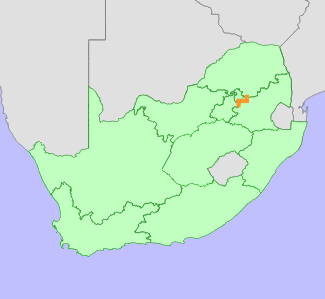|
Scientific Name | Encephalartos lanatus Stapf & Burtt Davy |
Higher Classification | Gymnosperms |
Family | ZAMIACEAE |
Common Names | Broodboom (a), Cycad (e), Mofaka (ns), Olifants River Cycad (e), Olifantsrivier-broodboom (a) |
National Status |
Status and Criteria | Vulnerable B1ab(v)+2ab(v) |
Assessment Date | 2020/05/13 |
Assessor(s) | J.D. Bösenberg, J.S. Donaldson & T. Steyn |
Justification | This species has a restricted range and occurs at fewer than ten locations. It therefore qualifies as Vulnerable under criterion B1+2 if there was any evidence of continuing decline. Until recently populations were regarded as stable and this species was therefore classified as NT. However, there is recent evidence of population declines due to illegal collecting and it is therefore classified as VU B1ab(v)+2ab(v). |
Distribution |
Endemism | South African endemic |
Provincial distribution | Gauteng, Mpumalanga |
Range | It occurs in the upper catchment area of the Olifants River in the City of Tshwane and Nkangala district municipalities of the Gauteng and Mpumalanga provinces in South Africa. It also occurs along the Little Olifants and Wilge rivers in this area. It occurs from 1,200 to 1,500 m asl. |
Habitat and Ecology |
Major system | Terrestrial |
Major habitats | Loskop Mountain Bushveld, Rand Highveld Grassland |
Description | It is usually found on the slopes of sheltered wooded kloofs and sandstone ridges where it occurs as an element of open to sometimes rather closed woodland communities. Sites are usually gentle to steep sloping, associated with scattered sandstone boulders and well drained soils. The species shows a definite preference for semi-exposed, steep sloping sites with a southern aspect. |
Threats |
| The agricultural development of the distribution area of Encephalartos lanatus would have had a minimal effect on the species due to the types of farming practices employed (Fourie 1984). The species was, in the past, also reportedly not popular with cycad collectors as these plants are sensitive to disturbance and any transplanting ends in the death of plants (Goode 1993). However, two changes now pose greater threats to this species. First, since 2015 there has been an increase in illegal collecting and this has now been recorded from a number of sites (T. Steyn pers. comm.) and, second, mining companies have applied for rights to mine in the core of the main distribution area (S. Sidersky pers. comm.) |
Population |
This is a locally abundant species and was previously regarded as stable due to landuse that was compatible with its survival. The populations were also relatively safe as they were not popular with cycad collectors due to their known sensitivity to disturbance and poor transplanting outcomes (Goode 1993). However, this situation seems to have changed and plants are now being illegally removed by collectors resulting in a decline in population numbers (T. Steyn pers. comm.).
|
Population trend | Decreasing |
Conservation |
| Conserved in two private nature reserves and a natural heritage site in Gauteng. |
Assessment History |
Taxon assessed |
Status and Criteria |
Citation/Red List version | | Encephalartos lanatus Stapf & Burtt Davy | VU B1ab(iii)+2ab(iii) | 2011.1 | | Encephalartos lanatus Stapf & Burtt Davy | VU B1ab(iii)+2ab(iii) | Raimondo et al. (2009) | | Encephalartos lanatus Stapf & Burtt Davy | Near Threatened | Pfab and Victor (2002) | | Encephalartos lanatus Stapf & Burtt Davy | Rare | Hilton-Taylor (1996) | | Encephalartos lanatus Stapf & Burtt Davy | Vulnerable | Hall et al. (1980) | |
Bibliography |
Burtt Davy, J. 1926. A manual of the flowering plants and ferns of the Transvaal with Swaziland, South Africa. Part I. Pteridophyta to Bombacaceae. Longmans, Green and Co. Ltd., London.
Donaldson, J.S. 2003. Cycads. Status survey and conservation action plan. IUCN/SSC Cycad Specialist Group, Gland, Switzerland; Cambridge, UK.
Fourie, S.P. 1984. Flora Conservation Plan: Encephalartos lanatus. Transvaal Chief Directorate of Nature and Environmental Conservation.
Goode, D. 1989. Cycads of Africa. Struik/Winchester, Cape Town.
Hall, A.V., De Winter, M., De Winter, B. and Van Oosterhout, S.A.M. 1980. Threatened plants of southern Africa. South African National Scienctific Programmes Report 45. CSIR, Pretoria.
Hilton-Taylor, C. 1996. Red data list of southern African plants. Strelitzia 4. South African National Botanical Institute, Pretoria.
Osborne, R. 1988. Focus on Encephalartos lanatus. Encephalartos 16:3-9.
Pfab, M.F. and Victor, J.E. 2002. Threatened plants of Gauteng, South Africa. South African Journal of Botany 68:370-375.
Raimondo, D., von Staden, L., Foden, W., Victor, J.E., Helme, N.A., Turner, R.C., Kamundi, D.A. and Manyama, P.A. 2009. Red List of South African Plants. Strelitzia 25. South African National Biodiversity Institute, Pretoria.
|
Citation |
| Bösenberg, J.D., Donaldson, J.S. & Steyn, T. 2020. Encephalartos lanatus Stapf & Burtt Davy. National Assessment: Red List of South African Plants version 2024.1. Accessed on 2025/11/05 |
 Comment on this assessment
Comment on this assessment

